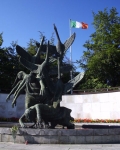Garden of Remembrance
Archaeology »
Archaeological Monuments » Garden of Remembrance
Garden of Remembrance - Ireland
Garden of Remembrance is located in memorial garden,Dublin.
Garden of Remembrance monument was established on 1971.
Primary threats to Garden of Remembrance :
The Garden was designed by Daithi Hanly. It is in the form of a sunken cruciform water-feature. Its focal point is a statue of the Children of Lir by Oisin Kelly, symbolizing rebirth and resurrection, added in 1971.
Historical facts of Garden of Remembrance :
- The Garden of Remembrance is a historically significant memorial located in Dublin, Ireland. It serves as a solemn tribute to those who lost their lives in the pursuit of Irish independence and in commemoration of the sacrifices made during various periods of struggle and conflict.
- The Garden of Remembrance was officially opened on Easter Monday, April 16, 1966, to mark the 50th anniversary of the 1916 Easter Rising. The design of the garden was created by the renowned Irish architect Daithí Hanly. It is a reflective and contemplative space that honors the memory of those who fought and died for Irish freedom.
- The centerpiece of the garden is the massive bronze sculpture, "Children of Lir," created by the sculptor Oisín Kelly. It depicts the figures of four children who represent the rebirth and renewal of the Irish nation. The sculpture is surrounded by a reflective pool of water, adding to the tranquility and solemnity of the memorial.
- The garden itself is designed in a cruciform shape, symbolizing sacrifice and remembrance. The paths and landscaping are carefully laid out, incorporating elements of Irish symbolism and mythology. The garden features Celtic motifs, stone walls, and plaques inscribed with verses from famous Irish poets, further enhancing its historical and cultural significance.
- The Garden of Remembrance holds particular importance in Irish history due to its connection with the 1916 Easter Rising. The Easter Rising was a pivotal event in the fight for Irish independence from British rule. It began on Easter Monday, April 24, 1916, when Irish rebels seized key locations in Dublin, including the General Post Office, and declared an independent Irish Republic.
- The Rising was ultimately suppressed by British forces, resulting in the loss of many lives on both sides. The leaders of the rebellion, including James Connolly, Patrick Pearse, and Thomas Clarke, were executed by the British, sparking outrage and further fueling the desire for Irish independence.
- The Garden of Remembrance serves as a poignant reminder of the sacrifices made during the Easter Rising and subsequent struggles for Irish freedom. It provides a space for reflection, remembrance, and contemplation of the courage and dedication displayed by those who fought for independence.
- Beyond the Easter Rising, the Garden of Remembrance represents a broader recognition of Irish history and the pursuit of freedom. It honors the memory of all those who lost their lives in the struggle for independence throughout the centuries, including those who fought in the Irish War of Independence (1919-1921) and the Irish Civil War (1922-1923).
- The Garden of Remembrance is not only a site of remembrance but also a venue for significant events and ceremonies. It is often the location for memorial services, wreath-laying ceremonies, and other commemorative events, particularly on important dates in Irish history.
- Visiting the Garden of Remembrance offers individuals an opportunity to connect with Ireland's past and pay tribute to the courage and sacrifice of those who fought for independence. The tranquil atmosphere, combined with the powerful symbolism of the memorial, creates a space for reflection and contemplation, fostering a deeper understanding of Irish history and the ongoing pursuit of freedom.

